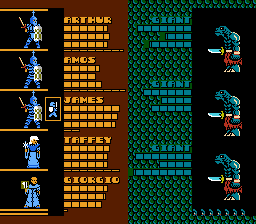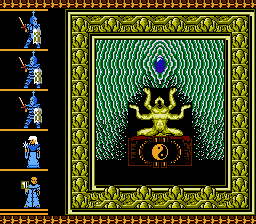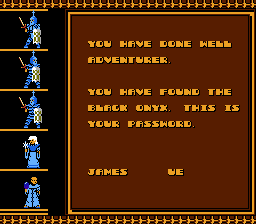2019-08-05: Super Black Onyx
Some time ago I wrote about The Black Onyx: one of the first JRPGs and an incredibly quirky and off-beat dungeon crawler released in Japan, by a European immigrant who wanted more Wizardry-like games on the market. The Black Onyx enjoyed quite a few re-releases on the likes of the Game Boy, MSX, and the SG-1000. The weirdest, though, is a sort of re-imagining of the game for the Famicom, titled Super Black Onyx.
To be clear, SBO is a very different game, but it does retain a lot of the quirks of TBO. I've been slowly (and I do mean slowly) chewing through it since I finished the PC-88 The Black Onyx last November. It wasn't a stream project, it wasn't a dedicated off-stream game. I mostly fired it up and continued my save whenever I got bored of everything else I was playing. That's why it's taken me nine months to finish. In truth, I can only take SBO in short stints. It's repetitive, slow, samey, and presents absolutely no onus to keep going except for mapping more dungeon floors and knowing (or at least hoping) you're getting closer to the titular black onyx.
On one positive note, despite being a Japanese title, it needs no localization. Enemy names are in English, there is no dialogue, and all the menuing is done with a pictograph menu completely devoid of text. There's not a single bit of Japanese text in the entire game. On the minus side, there really should been some text in the game's systems and the lack of dialogue means there's a lack of progression of any kind whether it be plot or mechanics.
To be fair, SBO is a mechanical step up from TBO. In TBO you had a party of fighters and you told them to fight until one side won. You had no menu, no magic, no options. In SBO you actually have choices to make, but it's all done in some weird alien interface that feels like someone was shown a dungeon crawler once and told to replicate the experience. Combat takes place in a static interface with your party on the left and foes on the right. As battle begins, you can select which weapon or spell each fighter should use, and they'll automatically attack the enemy across from them. They do this by throwing their weapon or spell across the field and it'll hover in front of its target. At this time you can mash A to attack with it, or press up or down on the D-pad to re-target. Depending on your dexterity, the weapon will remain in play for a certain amount of time, and its effectiveness is determined by your strength. Attacking or casting will lower both of these some amount until, eventually, the attack remains out for such a short period of time you can't attack at all.
It's an incredibly weird system, and one prone to death spirals since enemies also steal strength and dexterity when they hit, in addition to causing HP damage. To recover strength and dexterity you can defend, which doesn't seem to actually improve your defenses any. However, if enemies keep plugging away at you, your recovery might be quite slow. To supplement your attacks, you have two classes of spells: Monk spells and Mage spells. Monk spells are cast with runes and include effects like defense buffs, heals, and undead insta-kills. Mage spells are cast with gems and include several direct damage spells, and a few utility things like a guaranteed escape and a debuff. These follow the same rules regarding strength and dexterity as weapons.
You'll get familiar with combat too. The encounter rate is incredibly consistent, throwing a battle at you every three to six steps. It's an incredibly high rate, and the incredibly slow battles means about 90% of gameplay is spent in battle. Some of these fights can go on so long you could exit battle and completely forget where in the dungeon you were; a real fun thing for mapping!
Since the game completely lacks any kind of textual interfacing with the player, you have to recognize what each rune/gem looks like and learn what it does via experimentation. I wonder if the manual explained these; I didn't have access to it. I quickly identified the runes that heal and buff, as well as a few gems that did damage, warped me back to town, gave me a rough idea of where I was in the dungeon, and allowed me to save (yes, saving is a spell, but one everyone gets). Most of them I never really learned what they did.
Much like TBO, you start SBO in the middle of town with no real guidance on where to go or what to do. Also much like TBO, your objective is bog dead simple: find the Black Onyx, so you don't really need a lot of being told what to do. Unlike in TBO though, you can't make your entire party from the start; you have to recruit four allies from within town. Town is safe, allowing you to wander around until you encounter NPCs who are willing to join you. Once you have a balanced party of fighters, mages, and monks, you can outfit them at the shops (again, no inventory: buying an item just discards the prior one) and set off either up or down into the dungeon. As like in TBO, death is permanent. Once a character hits 0 HP, they die and must be completely replaced, along with their gear. I considered losing a single character a reset situation.
While TBO had an 8 floor dungeon, SBO's is... a little different. Linearly speaking it has over 60 floors, but most of them are tiny things with only a room or two before you find the next stairs. The truth of it, as I found checking out GameFAQs, is that the SBO world is actually 8 32x32 floors with the stairs up from floor 8 winding around to floor 1. At no point do different dungeon regions intersect, so you'd never know and it's not really important that the data's laid out this way... at least until the end when you enter the final region which seems to just be the negative space between the rest of the dungeon floors. Having a general idea of the shape of this space would probably help mapping it. The net result is a lot of floors surprisingly short and bereft of content, made up by volume.
Every few floors of dungeon you enter a new region with a different tileset, music, and enemy population. You start in a brown colored town then progress upward through a forest, a strange orange area, an ice dungeon, a spooky crypt, and eventually a city of gold connected to a golden maze within which the Onyx is hidden. You can also travel down to find an underground lake and a temple, these two areas containing some pretty important powerups but not ultimately getting you any closer to the Onyx. Unfortunately these are the only evolutions to the gameplay you see. Once you get a feel for combat, it's the same through the entire game; just with the numbers on the enemy side getting bigger as you progress through the dungeon regions. The music is also an earsore in most of these regions, alas.
Making the 60 floor traversal easier is the Onyx Wall mechanic. Every few floors you'll come to a solid black wall, much like in the original game. Touching it will allow you to warp back and forth between your two last touched walls. Keeping one of these points in either town, or next to a similar rest spot is, of course, highly recommended. Unlike in the original game, these onyx walls do not represent a single onyx monolith spearing the dungeon; they seem to just be strewn wherever.
As far as actually completing the game goes, nothing is stopping you from going straight up from the start, climbing up 44 floors, and finding the Onyx. You'd probably get murdered horribly before you get to floor 10, though. Instead, the intended path seems to be to putz around the early floors for a few levels, then head down to find the game's first restoration fountain in the underground and use the onyx walls there to establish your base of operations. In doing that you should have the experience to survive the early upward floors, and the gold to buy some gear. From there, there's three major important things to pick up:
- The Caliber sword around floor 15
- The Star Jewel around floor 30
- The Cudgel spell at the bottom of the dungeon around floor -15
These are the best-in-slot damage choices for the game's three classes. Though they take an extremely high amount of strength and dexterity to wield and can often only hit once per turn. They're easily the best choices for damage and remove the need to think about any other weapon/spell offense. They also have such short lifetimes in the air that you can't change targets, so they remove a large portion of the game's strategy and in-combat choice as well, alas. In addition to that, you can buy armor from the shops, with enough tiers available that you'll likely be upgrading for most of the game. That's a pretty big change from TBO where you could have the best gear by the game's half way point.
Experience is another strange beast. You gain experience based on how much damage you do, but the scaling is ridiculous. Around level 8 you'll start earning only 1 EXP per battle, regardless of how hard it is or how much you do. At this point you can still get large EXP gluts from special event rooms. These are otherwise useless rooms that provide you with a neat piece of scenic art when you enter them, and give everyone in your party half a level of experience. However these too eventually stop functioning, around level 9 or 10. After that point, you're stuck only earning 1 EXP per battle. At level 11, it's 1 EXP every 2 battles. This effectively sets a soft cap of level 11 for the game. I'm sure you could make it to 12, but it'd take such a long time, and the game seems to be scaled to be finished at level 11. Furthermore, it's quite clear that level 11 is close to, or at, the stat caps. I actually believe I had one of my fighters overflow his dexterity, leaving him unable to attack.
I guess I can't complain about such a low level cap considering the game is intended to be played with permadeath and having to recruit replacements for dead characters. Though this highlights another odd thing: near the end of the game you reach the lost city of gold... I guess. It's gold, it's a city, and it's a safe zone. This area contains level 10 recruitable characters, kind of invalidating all that grinding you did to level your starting squad. I guess it's not invalid because without the grind, you wouldn't be able to get to the city of gold, but it was still strange to see.
In any case, once you have the three super-weapons (or whatever it is you want to get before pushing to endgame) it really is a straight walk from floor 1 to floor 44 where the Onyx rests. The city of gold is floors 34-37 (and is, shockingly, three massive sprawling floors of absolutely nothing; not even encounters), and after that is a 7 floor slog through the large negative space between the regions in the 32x32x8 map. While prior floors may have been a couple of dozen tiles, the final floors are massive sprawling labyrinths. However even still, they're empty featureless labyrinths. The one sole exception is the floor immediately before the onyx, which contains a throwback to TBO in the form of a hallway of invisible one-way doors: doors/walls that aren't there when viewed from one side, but appear when you pass through them, trapping you outside the correct path to the finish. This was a common evil trick in TBO; it's used once, for one 15 tile hallway in SBO. Honestly? I'm glad, it was a dirty, infuriating trick.
The entire home stretch is probably best played by fleeing from everything. You've passed the final shops in the game, you should be level 10 or 11, there's nothing to gain from combat. There's also no final boss to Super Black Onyx, just like there was no final boss to its predecessor. You eventually stumble into a room on floor 44 and find the Onyx. From what I've heard, you have to have a monk in your party with max karma (which is gained and lost by talking to or attacking friendly NPCs). I had max karma just from playing the game, so I don't know if this is true or not.
Your reward for finding the Onyx is a single congratulatory screen and a password. Super Black Onyx has no password system, so maybe this was a mail-in contest thing, or maybe a sequel was planned. I don't know for sure.
So that's it. I can't really recommend Super Black Onyx to uh... anyone. It took me nine months to finish because I could only really slog through a few floors at a time before I had to put it down for awhile. The game's just nothing but a walk through a maze full of monotonous, pointless combat in an arcane, frustrating system. At least I've finished it now; I feel that's important.
tags: black_onyx, rpg, game_writeup



